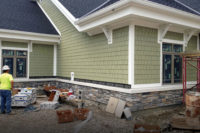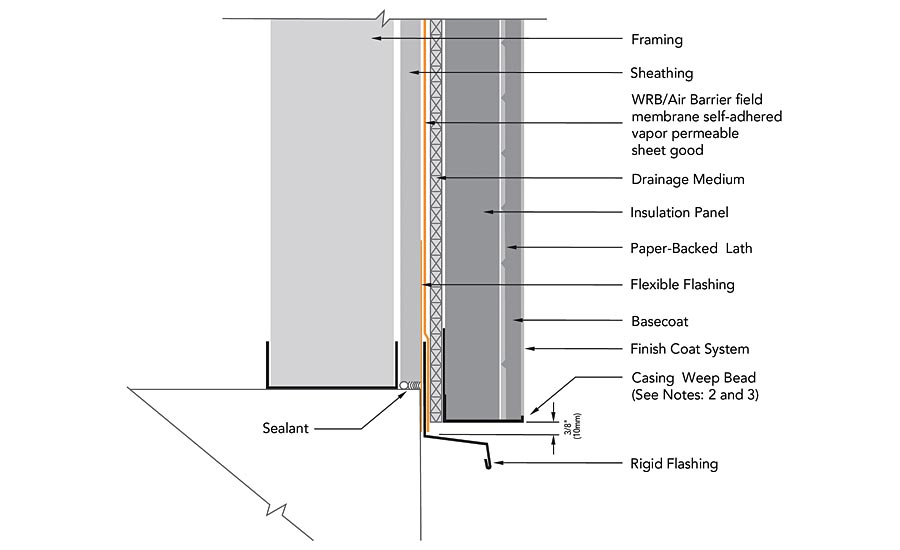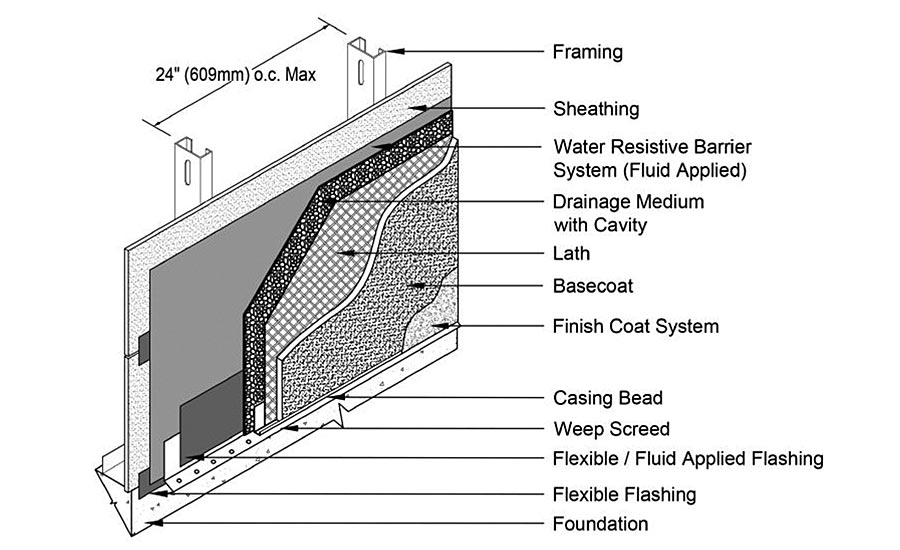Rainscreen Stucco Solutions
Tame the Rain

A high density polypropylene drainage mat, with integral filter fabric with a Class A rating attached to a WRB/air barrier.

Stucco is commonly installed over wood framing with plywood sheathing or steel framing with gypsum sheathing back-up walls. Stucco is arguably low maintenance and adaptable to both classical and modern architectural styles.

Exterior CI comes in many forms: polyiso, expandable polystyrene, extruded polystyrene, along with spray foam are some of the choices. Each available non-faced or with multiple options for facers such as aluminum foil or fiberglass laminated to the surface. Image courtesy of Rodenhouse Inc.

Stucco failure discovered on Schooner Cove condominiums in South Tampa, Fla., built by DR Horton. Courtesy of KIS Consulting, LLC.

The NFPA 285 test is performed on specific wall assemblies. Any deviation from the assembly details, other than like product replacements, require a separate NFPA 285 test. When a manufacturer denotes that their product is “NFPA 285 compliant,” what should be stated is that a specific wall assembly, which includes their product, has passed the test.

This assembly provides long-term durability with a high drying capacity for both the exterior and interior. It performs in multiple climate zones and can be adapted to various insulation types and thickness to achieve local code compliance.

WMS-4 Stucco Rainscreen Drainage System







The recent changes to commercial building codes have caused cascading complications relating to how we construct building enclosures. This has resulted in some of the “old methods” of cladding installation no longer meeting the current code in some locales. The introduction of continuous exterior insulation requirements with thermal breaks, air barriers and NFPA 285 requirements for water resistive barriers, have left many design professionals uncertain as to what is the correct design for a code compliant assembly that will produce a long-lasting installation that is free from water intrusion leaks. By emphasizing commercial rather than residential building assemblies, this article will shed new light on a long-standing complex and convoluted topic.
Three Coat Stucco vs. Lath
Let’s begin by examining traditional three coat stucco over lath, a common cost-effective cladding material used extensively in the Southwest region of the United States and elsewhere in North America. Light commercial and multi-family structures are often clad with this material. Stucco is commonly installed over wood framing with plywood sheathing, or steel framing with gypsum sheathing back-up walls. Stucco is arguably low maintenance and adaptable to both classical and modern architectural styles.
Stucco has excellent fire resistance, however it remains a cladding system that has experienced issues with water infiltration and corresponding construction defects. Mitigation of these failed stucco cladding assemblies can be extensive and costly. The introduction of air barriers into the code has the potential to further exacerbate the problem by changing the dynamics of a stucco assembly. The drying capacity of a non-rainscreen stucco installation is newly limited by the air barrier energy requirement of the building codes. The addition of a continuous exterior insulation material with low vapor permeance further complicates a conventional stucco assembly.
Devil’s in the Details
The introduction of water managed or rainscreen stucco assemblies as illustrated in the “Stucco Resource Guide” published by the Northwest Wall and Ceiling Bureau1, and the Minnesota Lath and Plaster Bureau2, has not been universally adopted by the industry. The reasons for this are unclear. Rainscreen stucco details have been in existence for more than 20 years and are incorporated by architects and designers that desire the architectural appeal of a stucco facade yet recognize the limitations of this traditional material. Window flashing components and through-wall flashings that function to drain stucco panels to the exterior are a few of the essential details of a successful water-managed stucco cladding installation. Drainage design at soffit transitions and the base of wall locations should also be incorporated. A drainage cavity that provides a true capillary break along with drainage to the exterior and airflow for enhanced drying are the keys to a successful rainscreen stucco installation. The depth or size of the drainage cavity should be determined by multiple variables, including:
- Geographical location
- Prevailing weather directions
- Roof overhangs
- Height of the building
The number of annual potential drying days can be as important as the amount of accumulated rainfall.
Where’s the Difficulty?
Now, consider what adding a continuous exterior insulation requirement to a stucco cladding assembly requires. Without insulation, a rainscreen stucco system was easy to implement. Just create a cavity with a drainage mat between the vapor permeable WRB/AB (air barrier) and the stucco system. Cover the drainage mat with a lightweight filter fabric to keep the scratch and brown coats from clogging the drainage cavity. Flash all penetrations to drain to the exterior, separate your floor-lines with through-wall flashings, and then you have a successful installation. What makes the addition of exterior insulation difficult?
Various types of continuous insulation and uses should be considered. Rigid insulations come in many forms. Polyiso, expandable polystyrene, extruded polystyrene, along with spray foam are some of the choices. Each are available non-faced or with multiple options for facers such as aluminum foil or fiberglass laminated to the surface. Wide varieties of densities are available and various depths and R-values exist as well. The manufacturers of these insulation products do not yet recommend mineral fiber insulation in a continuous exterior application for traditional three coat stucco installation, as of the date of this article. However, testing is currently underway. An excellent source for additional information can be found in “Plaster Assemblies: Exterior Insulation on Framed Walls,” a publication of the Minnesota Lath and Plaster Bureau, 20152. Additionally, many of the fine informative articles published by the Building Science Group offer information on insulation choices, as well as rainscreen assemblies.
A Test is Best
After weighing all the choices for exterior continuous insulation, with their various merits, drawbacks and limitations, a “code compliant” decision should be made, not only for the energy code, but also arguably and more importantly for the fire code. As of the 2012 International Building Code, all wall assemblies, including stucco, containing a WRB and foam plastic insulation, require compliance with NFPA 285 testing parameters.
For those unfamiliar with NFPA 285, a brief description is: “a full-scale assembly test designed to assess the potential for damage caused by a fire starting inside a building, progressing through an exterior window opening and traveling up the outside of the structure.” It is a two-story mockup of the entire wall assembly from inside to outside, with a window opening, minus the window. Results are measured by both flame spread vertically and laterally along with temperature readings at multiple locations throughout the wall, over a specified time. For a detailed explanation by the “father” of this test, Jesse Beitel of Jensen Hughes, please see the publication Journal of Building Enclosure Design, “NFPA 285: What You Need to Know.”3
NFPA 285 is an assembly test. Substitutions of individual components within a specific test are not allowed without justification. The total amount of possible permutations of wall assemblies that require testing is staggering. In the absence of a full-scale test, an engineering judgment letter or an engineering evaluation report by a qualified fire consultant may be submitted to the Authority Having Jurisdiction.
In recent years, manufacturers of cladding, insulation and WRB/AB materials have invested thousands of dollars towards NFPA 285 testing and engineering evaluations. Some of these costs can run as high as $40,000 per test. If a manufacturer states their material is “NFPA 285 compliant,” ask and require proof, preferably in a written statement. Failure to do so before commencing with installation can result in costly delays and even denial of certificate of occupancy by the AHJ for the project. It is important to select manufacturers with the technical expertise and an established professional relationship with qualified fire consulting firms. These consulting firms should be familiar with the manufacturer’s materials and be willing to submit the necessary documentation verifying the designed assembly as NFPA 285 compliant.
Synchronizing Sequence
Prior to finalizing the design of the wall assembly and verifying NFPA 285 compliance, the sequence of components must be considered. The choice of materials can affect where the component should be placed in the assembly. Water resistance, vapor permeability, fastener sealing and even flammability are factors that must be considered. For the purpose of this article, we will describe a sequence that provides long-term durability with a capacity for high drying to both the exterior and interior, with ease of installation, which will extend the life of the stucco cladding. This assembly will work equally well with metal framed or wood framed back-up walls and can accommodate additional insulation within the stud cavity for added sound and energy performance. This assembly can provide excellent performance in multiple climate zones by varying the insulation types and thickness to achieve local code compliance.
The WRB/AB system is fully detailed into all rough openings and penetrations with a vapor permeable liquid flashing component. The next step would be high-density polypropylene drainage mat, with integral filter fabric with a Class A rating per ASTM E 84 followed by continuous exterior rigid insulation that has been NFPA 285 tested with a maximum of 2 inch depth. Finally, the stucco lath and accessories are installed over the rigid insulation. The insulation manufacturer or AHJ may require a slip sheet of building paper, between the lath and the rigid insulation.
By locating the drainage mat component between the continuous rigid insulation and the drainage surface of the WRB, moisture can escape the structure to the exterior. Proper flashings at this interface are crucial to allow unobstructed vertical drainage. Locations such as heads of windows, doors and floor line transitions are critical areas to avoid the accumulation of incidental moisture. These areas require proper shingle fashion integration with the fully adhered WRB/AB sheet material. For the purpose of the above example, the choice of rigid insulation is generic. However, the exact product, thickness and manufacturer are required for NFPA 285 compliance documentation. It is highly recommended to avoid last minute substitutions without checking with a fire consultant. It should be noted that similar types of insulation in comparable depths and R-values from different manufacturers do not necessarily burn at the same rates.
Conclusion
As stated previously, this article is not meant to be an exhaustive or comprehensive document on drainage stucco systems with continuous exterior insulation. Only that cost effective, code compliant, and durable traditional three-coat stucco cladding assemblies are still viable cladding materials that can be installed to meet today’s evolving code requirements. The NWCB has recently issued a new updated version of their Stucco Resource Guide, containing additional rainscreen details. These additional details will encourage architects and building enclosure consultants to implement these improvements.
In conclusion, by adopting a rainscreen approach, traditional three coat stucco installations can provide long-term durability and minimize the water intrusion issues that have plagued this otherwise low maintenance, fireproof cladding material.
Citations:
Stucco Resource Guide -4th Edition (2016)
Plaster Assemblies: Exterior Insulation on Framed Walls, by Steven Pedracine CSI, CDT Executive Director, Minnesota Lath and Plaster Bureau and David Bryan AIA, LEED Third Level Design
Journal of Building Enclosure Design, Summer 2012, “NFPA 285: What You Need to Know” Jesse Beitel of Jensen Hughes
Looking for a reprint of this article?
From high-res PDFs to custom plaques, order your copy today!














